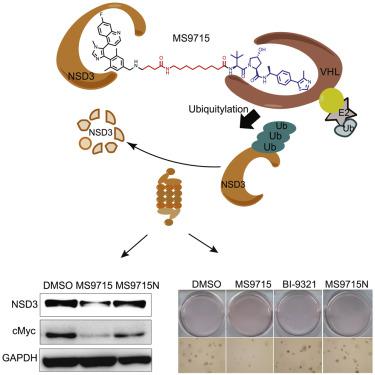Cell Chemical Biology ( IF 6.6 ) Pub Date : 2021-08-31 , DOI: 10.1016/j.chembiol.2021.08.004 Chenxi Xu 1 , Fanye Meng 2 , Kwang-Su Park 2 , Aaron J Storey 3 , Weida Gong 4 , Yi-Hsuan Tsai 4 , Elisa Gibson 5 , Stephanie D Byrum 3 , Dongxu Li 1 , Rick D Edmondson 3 , Samuel G Mackintosh 3 , Masoud Vedadi 6 , Ling Cai 7 , Alan J Tackett 3 , H Ümit Kaniskan 2 , Jian Jin 2 , Gang Greg Wang 8

|
Nuclear receptor binding SET domain protein 3 (NSD3), a gene located within the 8p11-p12 amplicon frequently detected in human cancers, encodes a chromatin modulator and an attractive onco-target. However, agents that effectively suppress NSD3-mediated oncogenic actions are currently lacking. We report the NSD3-targeting proteolysis targeting chimera (PROTAC), MS9715, which achieves effective and specific targeting of NSD3 and associated cMyc node in tumor cells. MS9715 is designed by linking BI-9321, a NSD3 antagonist, which binds NSD3’s PWWP1 domain, with an E3 ligase VHL ligand. Importantly, MS9715, but not BI-9321, effectively suppresses growth of NSD3-dependent hematological cancer cells. Transcriptomic profiling demonstrates that MS9715, but not BI-9321, effectively suppresses NSD3-and cMyc-associated gene expression programs, resembling effects of the CRISPR-Cas9-mediated knockout of NSD3. Collectively, these results suggest that pharmacological degradation of NSD3 as an attractive therapeutic strategy, which co-suppresses NSD3- and cMyc-related oncogenic nodes, is superior to blocking the PWWP1 domain of NSD3.
中文翻译:

靶向 NSD3 的 PROTAC 抑制癌细胞中的 NSD3 和 cMyc 致癌节点
核受体结合 SET 结构域蛋白 3 (NSD3) 是一种位于人类癌症中经常检测到的 8p11-p12 扩增子内的基因,它编码染色质调节剂和有吸引力的致癌靶标。然而,目前缺乏有效抑制 NSD3 介导的致癌作用的药物。我们报告了 NSD3 靶向蛋白水解靶向嵌合体 (PROTAC),MS9715,它实现了肿瘤细胞中 NSD3 和相关 cMyc 节点的有效和特异性靶向。MS9715 是通过将结合 NSD3 的 PWWP1 结构域的 NSD3 拮抗剂 BI-9321 与 E3 连接酶 VHL 配体连接而设计的。重要的是,MS9715,而非 BI-9321,能有效抑制 NSD3 依赖性血液癌细胞的生长。转录组学分析表明,MS9715(而非 BI-9321)有效抑制 NSD3 和 cMyc 相关基因表达程序,类似于 CRISPR-Cas9 介导的 NSD3 敲除的效果。总的来说,这些结果表明,NSD3 的药理学降解作为一种有吸引力的治疗策略,可以共同抑制 NSD3 和 cMyc 相关的致癌节点,优于阻断 NSD3 的 PWWP1 结构域。











































 京公网安备 11010802027423号
京公网安备 11010802027423号